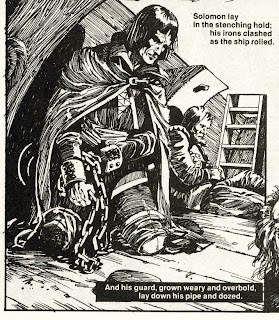Heavy Metal December 1977: Making My Own Christmas Card
For Christmas 2009 I decided to do something different in terms of my Christmas cards; rather than picking up some styles from the Hallmark store, or the rack at 'The Crystal Fox' (a New Age boutique on Main Street in Laurel, Maryland), I would make my own.
I investigated a number of custom ‘photo card’ websites, and eventually settled on
Vistaprint, mainly because their pre-formatted styles allowed for a design with the photo occupying the entire front of the card, as opposed to being shrunk and nested within an ornate border or frame. Vistaprint also provided a template ‘blank’ 5” x 7” folded card with a vertical (portrait) orientation.
For the card, I used a 200 dpi scan (2.5 MB jpeg) of the cover of Heavy Metal magazine’s December 1977 issue: a priceless Jean Solè portrait of Santa Claus as a menacing biker (!), with a ‘Joyeux Noel’ message displayed on a banner across the bike’s handlebars.
So how did the whole experience go ?
The
pluses:
-the image on the cards reproduced with good quality
-at $20 total (including shipping and handling) for 10 cards, the per-card price of $2 was reasonable.
-the price includes 10 white envelopes sized to hold a 5” x 7” card
-the interval from when I placed my order online until I received the cards in the snail mail was 9 days.
The
minuses:
-the Vistaprint card design webpage is a pain to use. Basically, you click thru successive screens to upload your image, and then you go thru various menus to select the options and features you want, such as text on the front of the card. This sounds good in theory, but there are annoyances; for example, I was forced to include text and an image on the inside the card, when I didn’t want this option.
-I also tried selecting different colors for the interior text (as opposed to just b &w), but the user interface was so poorly designed I had no way of telling if my selection had registered in the final card design (it hadn’t).
-after finalizing your card design, getting to the payment and order screens involves a numbing click-through of 7 – 8 further screens, offering all sorts of cheesy tchotchkes and come-ons (placing your card image onto a poster, or putting it on a coffee mug; orders for personalized address labels, pencils with your name embossed on them in gold script, etc).
These screens are deliberately set up to make it very easy for you to mistakenly click the wrong button and inadvertantly add 5 – 10 dollars’ worth of stuff, or unnecessary card features, you don’t really want.
And of course, there are all sorts of cunningly hidden ‘opt-out’ buttons that you must find and select in order to avoid being deluged with regular email sales pitches from Vistaprint and its business partners.
All in all, making my own card was a worthwhile endeavor. Just be careful as you go about the process with the online ordering. And, as Christmas time draws closer, I’m sure the custom card manufacturing services will get ever-heavier traffic, so you may want to allow for sufficient time between ordering and receipt of the finished product in order to get your cards mailed before the holiday arrives.





































































